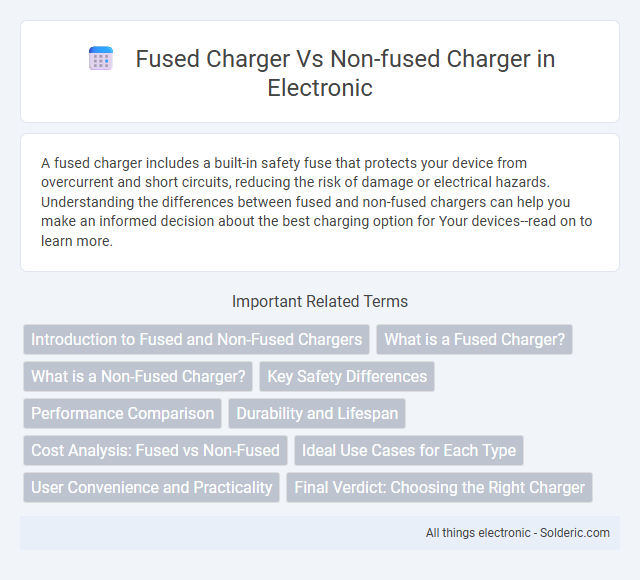A fused charger includes a built-in safety fuse that protects your device from overcurrent and short circuits, reducing the risk of damage or electrical hazards. Understanding the differences between fused and non-fused chargers can help you make an informed decision about the best charging option for Your devices--read on to learn more.
Comparison Table
| Feature | Fused Charger | Non-Fused Charger |
|---|---|---|
| Safety | Built-in fuse protects against current surges and short circuits | No fuse; higher risk of damage from electrical faults |
| Cost | Generally higher due to added safety component | Lower cost, but potentially more expensive in repairs |
| Durability | Greater longevity with protection from overloads | Prone to failure if exposed to electrical surges |
| Maintenance | Fuse replacement required if blown | No fuse; easier to maintain but riskier |
| Use Case | Ideal for sensitive devices and safety-critical environments | Suitable for low-risk applications and cost-sensitive users |
Introduction to Fused and Non-Fused Chargers
Fused chargers incorporate an internal fuse designed to protect electrical devices by interrupting the circuit during overloads or short circuits, enhancing safety and preventing potential damage. Non-fused chargers lack this protective element, relying solely on the device's internal safeguards or external protection mechanisms, which may increase risk during power surges. Choosing a fused charger is crucial for environments with frequent electrical fluctuations, as it ensures better circuit protection and prolongs device lifespan.
What is a Fused Charger?
A fused charger incorporates an internal fuse designed to protect electronic devices by interrupting the power supply during overcurrent or short circuit situations. This safety feature minimizes the risk of damage to both the device and the charger, enhancing longevity and reliability. Non-fused chargers lack this protective component, increasing the potential for electrical hazards or device failure.
What is a Non-Fused Charger?
A non-fused charger lacks an internal fuse to protect against electrical surges or short circuits, making it less safe compared to fused chargers. Without this built-in safety feature, your device is more vulnerable to potential damage from power fluctuations or faults. Choosing a fused charger can provide better protection for both your device and your personal safety.
Key Safety Differences
Fused chargers include an internal fuse that protects your devices from electrical surges and short circuits, reducing the risk of damage and fire hazards. Non-fused chargers lack this protective component, making them more vulnerable to overheating and potential safety failures. Choosing a fused charger enhances the overall safety of your electronic devices and provides peace of mind during use.
Performance Comparison
Fused chargers provide enhanced safety by incorporating a built-in fuse that prevents overheating and protects your devices from power surges, ensuring reliable performance under varying electrical conditions. Non-fused chargers lack this protective feature, which can lead to potential damage or reduced lifespan in case of voltage spikes or short circuits. Choosing a fused charger improves durability and consistent power delivery, making it a smarter investment for maintaining optimal device performance.
Durability and Lifespan
Fused chargers provide enhanced durability and extended lifespan by incorporating built-in protection against voltage spikes and short circuits, preventing damage to the internal components. Non-fused chargers lack this protective element, making them more susceptible to failure from electrical faults, reducing their overall longevity. Choosing a fused charger safeguards your device and investment, ensuring consistent performance over time.
Cost Analysis: Fused vs Non-Fused
Fused chargers generally come with a higher upfront cost due to the integrated safety fuse that protects your devices from power surges and short circuits. Non-fused chargers are often cheaper but may lead to increased expenses over time because they lack built-in protection, which can result in damage to your electronics and potential replacement costs. Choosing a fused charger enhances long-term cost efficiency by minimizing the risk of device failure and reducing maintenance or replacement expenses.
Ideal Use Cases for Each Type
Fused chargers are ideal for applications requiring enhanced safety and protection against electrical faults, such as charging devices in industrial environments or sensitive electronics needing overcurrent protection. Non-fused chargers suit simpler, low-risk scenarios like basic consumer electronics where cost efficiency and compact design are prioritized. Choosing the appropriate charger depends on the device's power requirements and the level of electrical protection necessary.
User Convenience and Practicality
Fused chargers provide enhanced user convenience by incorporating built-in safety features that protect devices from electrical surges and short circuits, reducing the risk of damage and the need for external fuses. Non-fused chargers lack this integrated protection, potentially leading to increased maintenance and the inconvenience of replacing separate fuses. The practicality of fused chargers lies in their all-in-one design, offering a safer, more reliable charging experience for everyday use.
Final Verdict: Choosing the Right Charger
Fused chargers provide enhanced safety by incorporating a fuse that protects devices from power surges and short circuits, making them ideal for sensitive electronics. Non-fused chargers may be more affordable but lack this crucial protection, increasing the risk of damage to connected devices. Choosing a fused charger is the best option for durability and safety, especially when charging valuable gadgets or frequently exposed to unstable power sources.
fused charger vs non-fused charger Infographic

 solderic.com
solderic.com